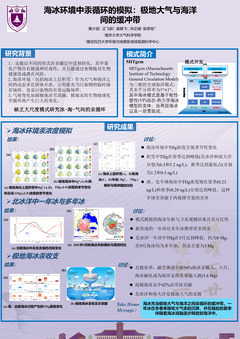报告详情
Modeling the mercury cycle in the sea ice environment: A buffer between the polar atmosphere and ocean
编号:3287
访问权限:私有
更新:2023-04-25 20:04:35
浏览:567次
张贴报告
摘要
Sea ice (including overlying snow) is a dynamic interface between the atmosphere and the ocean, and is crucial for the mercury (Hg) cycle in polar oceans. However, large-scale and process-based numerical models for Hg in the sea ice environment remain scarce, impeding our comprehension of regional and global Hg cycling. To bridge this gap, we developed a comprehensive simulation of the Hg cycling across the ocean-sea ice-atmosphere interface based on available polar cryospheric Hg data. Our findings revealed that the seasonal patterns of average snow content of total Hg (THg) are predominantly governed by the thermodynamic variation of snow and deposition, culminating in a springtime peak (6.3 and 5.2 ng/L for Arctic and Antarctic snow, respectively) and a nadir during ice formation (1.2 and 0.5 ng/L, respectively). Conversely, average THg concentrations in Arctic and Antarctic sea ice peak in summer (0.23 ng/L) and spring (0.28 ng/L), respectively, due to the snow Hg transmission. This hemispheric discrepancy arises from heavy snowfall in the Southern Ocean, causing frequent snow flooding, while the Arctic experiences less of this process. Overall, first-year sea ice acts as a buffer that receives atmospheric Hg during the ice growth season, and subsequently collapses in the succeeding summer, leading to a cascading of retained Hg to the underlying ocean. This implies a potential impact on the seasonal variation of polar atmospheric and seawater Hg concentrations. Our model contributes to assess climate change effects on polar Hg cycles and aids in evaluating the Minamata Convention's effectiveness for Arctic populations.
关键词
Mercury, Sea Ice, Snow, polar oceans, MITgcm
报告人

黄少剑
南京大学稿件作者
全部评论
重要日期
-
会议日期
05月05日
2023
至05月08日
2023
-
03月31日 2023
初稿截稿日期
-
05月25日 2023
注册截止日期
主办单位
青年地学论坛理事会
中国科学院青年创新促进会地学分会
中国科学院青年创新促进会地学分会
承办单位
武汉大学
中国科学院精密测量科学与技术创新研究院
中国地质大学(武汉)
中国科学院精密测量科学与技术创新研究院
中国地质大学(武汉)



发表评论